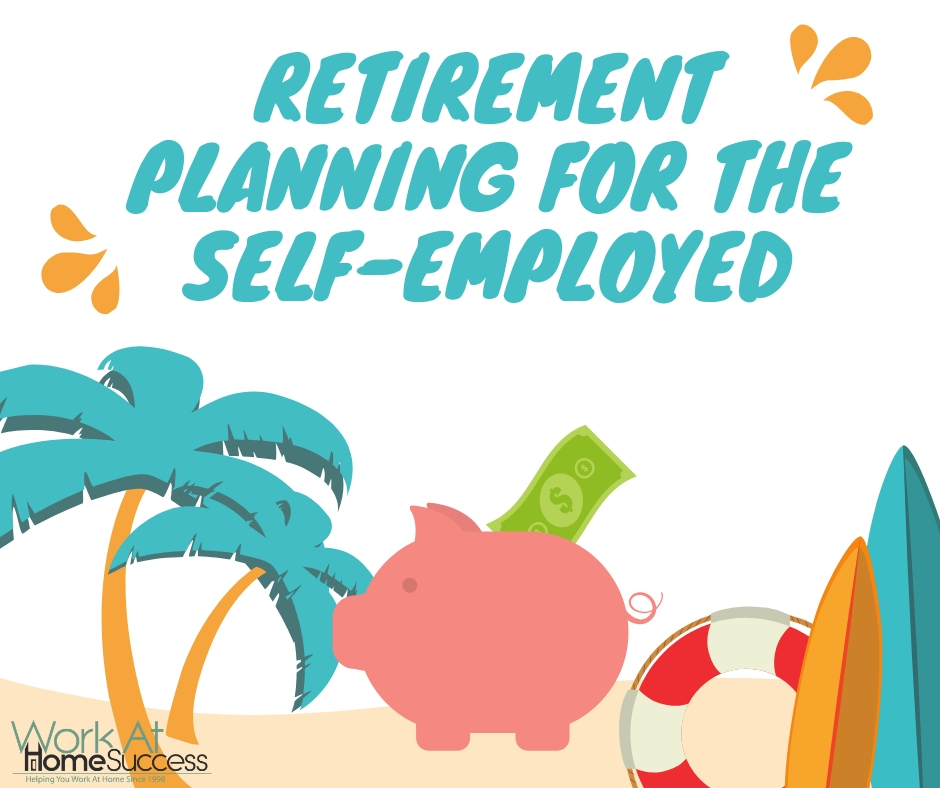Retirement Planning for the Self-Employed
When I started WAHS, I was a young mom more worried about building a college fund than retirement. Now, twenty years later, I’ve shifted my financial focus to retirement. As much as I like my work, I’ve come to a time in my life where I’d like to work less and play more!
The thing about retirement planning is that it should start while you’re young, especially if you’re self-employed. While you should be paying social security when you file your taxes, you don’t want to rely on it alone to cover your expenses when you retire. Especially if you’re under 40. According to NOLO, the next twenty to twenty-five years will likely see big changes in social security that can mean a 25% reduction in benefits. As a home business owner, you don’t have an employer helping you sock away money for your retirement. It’s up to you plan and save for your retirement.
NOTE: I’m not a money expert, so be sure to consult a professional about your financial and retirement needs.
How Much Do You Need for Retirement?
Here are a few questions to answer to determine how much you’ll need to save to afford a retirement that allows you to continue to pursue your goals.
1) Decide what you want in your retirement in financial terms.
Do you want to pay off your home or sell it and buy an RV to travel the country? How much do you want to earn each month, taking into consideration inflation and cost increases?
2) What age do you want to retire at?
The sooner you stop working, the more money you’ll need in retirement.
3) What is your life expectancy?
Of course, this is a difficult question to answer as no one knows when they’ll die. While life expectancy has been increasing due to advances in medicine and improved lifestyle choices. Smoking, unhealthy eating, sedentary life, and other factors can reduce your life expectancy. The CDC reports the average life expectancy is 78.8 years. The longer you live, the more you’ll need in retirement.
4) Factor in increased medical costs.
The older you get, the more likely you’ll need medical treatment. Even people with healthy lifestyles can develop medical issues as they age. I can attest to this. I’ve come to an age where there are more screening tests, and higher risks of certain ailments. I’m a healthy person, but our medical costs have gone up significantly over the last few years.
5) What are your plans for assisted living?
The older you get, the more likely you’ll need help and possibly regular support, which is expensive.
These are just a few of the financial considerations you need to make as you plan for retirement. Many financial planning and investment businesses offer retirement calculators that can help.
How to Save for Retirement
 Once you have a ball-park idea of the amount of money you need to afford your retirement goals, you need to start saving. Here’s how:
Once you have a ball-park idea of the amount of money you need to afford your retirement goals, you need to start saving. Here’s how:
1) Take stock of your current financial situation.
What are your current assets (i.e. your home) and liabilities (i.e. mortgage). The Social Security Administration sends statements to people ages 25, 30, 35, 40, 45, 50, 55, and 60 and over who aren’t receiving benefits. Or you can request a Social Security statement online, which will tell you how much you’ll receive in payments at various ages of retirement. Other financial assets to consider include stocks, bonds, 401ks and any other money or investment accounts.
2) Determine the value of these assets at the time of retirement.
This will be a guestimate because it’s difficult to predict economic growth. There are some generic estimates you can use. For example, the average home appreciation in the U.S. is about 3-5% according to Zillow. Of course, much depends on the area you live and the current economic state. Your financial planner or investment sources should be able to give you an estimated growth of your assets.
3) Do you need to save more?
Based on your current financial situation, your current financial planning activities and best guess at future retirement income, do you have enough? If you do, good for you. If not, it’s time to save more. Here are a few tips to boost retirement savings:
- Keep on top of your personal and business finances.
- Pay off debt and invest the money once used for debt into your retirement.
- Don’t touch your retirement accounts until you’re ready to retire.
- If you have a spouse that works a traditional job, learn about the company’s retirement and pension options and maximize what it offers.
- Invest in a retirement account. Some retirement options for the self-employed include the Simple IRA and SEP IRA.
Need more resources? Here are a few books and websites to check out for more information:
If you’re 50 or older…
The Charles Schwab Guide to Finances After Fifty
If you’ve got more time…
Websites
Do you have retirement savings ideas? Let us know in the comments below!
[click_to_tweet tweet=”Tips to figuring out how much money you need to save, and ideas and resources on how you can save for retirement when you’re self-employed #retirement #financialplanning #selfemployed” quote=”Tips to figuring out how much money you need to save, and ideas and resources on how you can save for retirement when you’re self-employed #retirement #financialplanning #selfemployed”]

